
Chacornac is an irregular lunar impact crater attached to the southeast rim of the crater Posidonius. It lies just to the east of the Mare Serenitatis, and north of the crater Le Monnier. The crater is named after French astronomer Jean Chacornac.
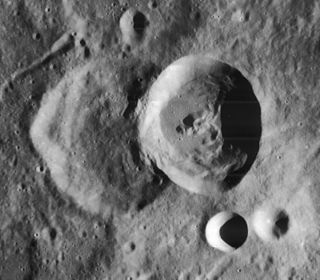
Sirsalis is a relatively young lunar impact crater located near the western lunar limb, to the southwest of the Oceanus Procellarum. The crater lies across a ridge that runs in a north–south direction. It has a sharp edge and a low central peak. The crater overlaps the slightly larger and older Sirsalis A to the west-southwest, and the two form a distinctive feature.

Humboldt is a large lunar impact crater that is located near the eastern limb of the Moon. Due to foreshortening this formation has an extremely oblong appearance. The actual shape of the crater is an irregular circle, with a significant indentation along the southeastern rim where the prominent crater Barnard intrudes. To the north-northwest of Humboldt is the large crater Hecataeus. Phillips is attached to the western rim. The rim of Humboldt is low, worn, and irregular in outline. The central peak forms a range on the crater floor. The floor surface contains a network of rilles forming a pattern of radial spokes and concentric arcs. There are also some dark patches located near the walls to the northeast, northwest, and southeast. There is a chain of craters leading from the northwest crater rim to a distance almost as long as the crater is wide. This formation is designated Catena Humboldt. Due to its location near the lunar limb, little detail was known about this crater until it was photographed by orbiting spacecraft.

Boguslawsky is a lunar impact crater that is located near the southern lunar limb. It lies to the northwest of the slightly larger crater Demonax, and southwest of the concentric crater Boussingault. Due to its location, this crater appears very oblong in shape because of foreshortening.

Cavendish is a lunar impact crater that is located in the southwest part of the Moon, to the southwest of the larger crater Mersenius. It lies between the smaller craters Henry to the west-northwest and de Gasparis to the east-southeast.

Littrow is a lunar impact crater that is located in the northeastern part of the Moon's near side, on the east edge of Mare Serenitatis. Its diameter is 29 km. The crater is named after Bohemian astronomer Joseph Johann Littrow. Some distance to the northeast is the prominent crater Römer, while to the south is Vitruvius.

Prinz is the lava-flooded remains of a lunar impact crater on the Oceanus Procellarum. It was named after German-Belgian astronomer Wilhelm Prinz. The formation lies to the southwest of the prominent crater Aristarchus. To the north-northeast is the flooded crater Krieger.

Adams is a lunar impact crater that is located in the rugged southeastern section of the Moon, near the lunar limb. It lies just to the southwest of the crater Legendre. To the northwest are the craters Hase and Petavius, and to the southwest is Furnerius. To the southwest of Adams is a system of rilles designated the Rimae Hase. The longest of these rilles follows a course to the southeast.

Boss is a lunar impact crater that is located along the northeast rim of the Moon's near side. Due to its location, the crater is viewed from the side by observers on the Earth, and its visibility is subject to libration effects.
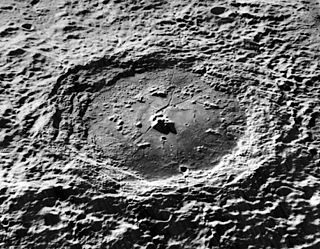
Compton is a prominent lunar impact crater that is located in the northern hemisphere on the far side of the Moon. It lies to the east of the Mare Humboldtianum, and southwest of the walled plain Schwarzschild. To the southeast of Compton is the heavily eroded crater Swann.

Boltzmann is an old lunar impact crater that is located along the southern limb of the Moon, in the vicinity of the south pole. At this location the crater is viewed from the side from Earth, and so not much detail can be seen. It is located to the north of the walled plain Drygalski, and to the west of the crater Le Gentil.
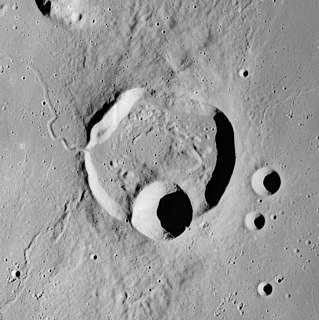
Krieger is a lunar impact crater on the eastern part of the Oceanus Procellarum. It is located to the north-northwest of the flooded crater Prinz, and north-northeast of the prominent ray crater Aristarchus. To the northwest lies the small Wollaston.
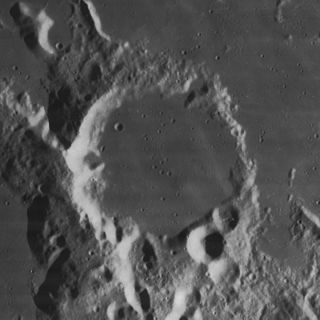
Capuanus is a lunar impact crater that lies along the southern edge of the Palus Epidemiarum. It was named after Italian astronomer F. Capuano di Manfredonia. The outer rim is eroded and indented by lesser crater impacts, with notches in the north, west, and southern parts of the rim. The interior floor has been resurfaced by basaltic lava, which is connected to the surrounding lunar mare by a narrow, crater-formed gap in the northern rim. The floor is particularly notable for the hosting a number of domes, which are believed to have formed through volcanic activity.

Cook is a lunar impact crater that lies in the western part of the Mare Fecunditatis, just to the southeast of the prominent crater Colombo. To the southwest is Monge.

Darwin is a lunar impact crater of the type categorised as a walled plain. It lies in the southeastern part of the Moon, and is sufficiently close to the limb to appear significantly foreshortened when viewed from the Earth. Attached to its southern rim is Lamarck. To the northeast is the dark-floored crater Crüger.

d'Alembert is a large lunar impact crater located in the northern hemisphere on the far side of the Moon, to the northeast of the somewhat smaller walled plain Campbell. Astride the southwest rim of d'Alembert is Slipher. To the north is the crater Yamamoto, and to the south-southwest lies Langevin. This walled plain has the same diameter as Clavius on the near side, making it one of the largest such formations on the Moon.
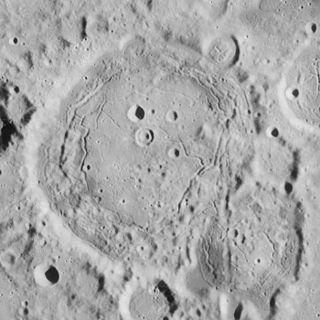
Lavoisier is a lunar impact crater that is located near the northwestern limb of the Moon, at the western edge of the Oceanus Procellarum. It is named after the French chemist Antoine Lavoisier. It is located to the southwest of the crater von Braun and southeast of Bunsen. Due south of Lavoisier is the disintegrated crater Ulugh Beigh.
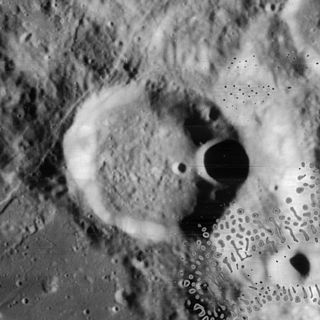
Liebig is a lunar impact crater that is located to the south-southeast of the crater Mersenius, and west of the Mare Humorum in the southwest part of the Moon. To the southwest of Liebig is the slightly smaller crater de Gasparis.

Palmieri is a lunar impact crater that lies to the southwest of the Mare Humorum, in the southwestern quadrant of the Moon's near side. It lies due south of the crater Liebig and east-northeast of the larger Fourier.
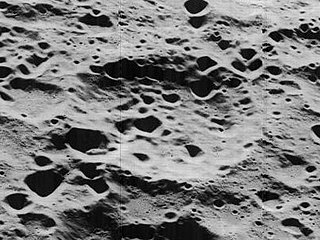
Dunér is an old lunar impact crater that is located in the northern hemisphere on the far side of the Moon. It lies to the southeast of the crater Chernyshev, and west-southwest of the Perkin–Debye crater pair.





















